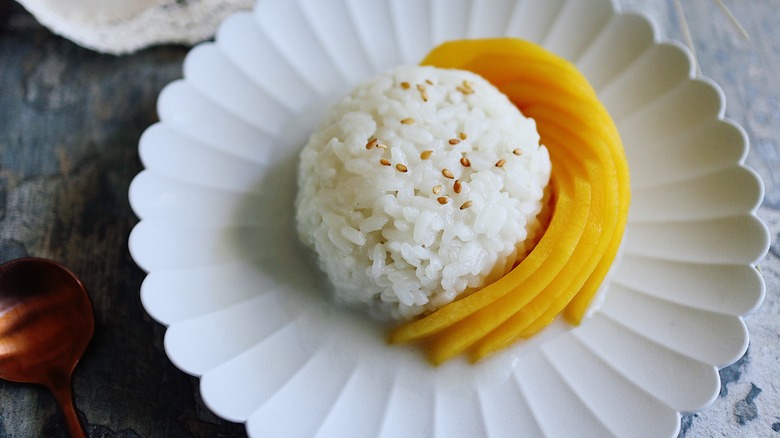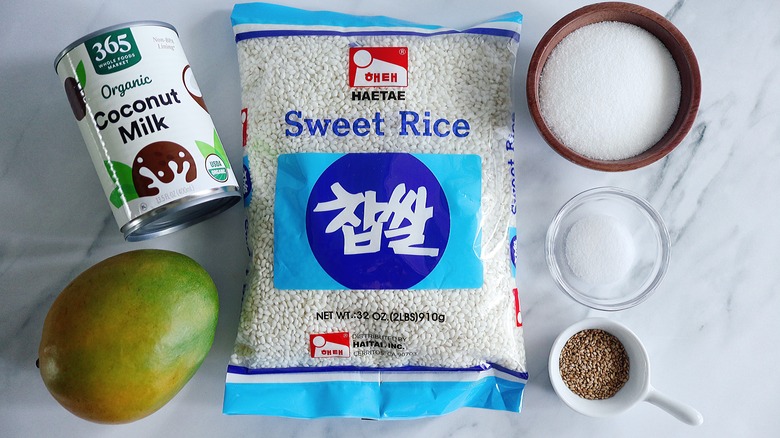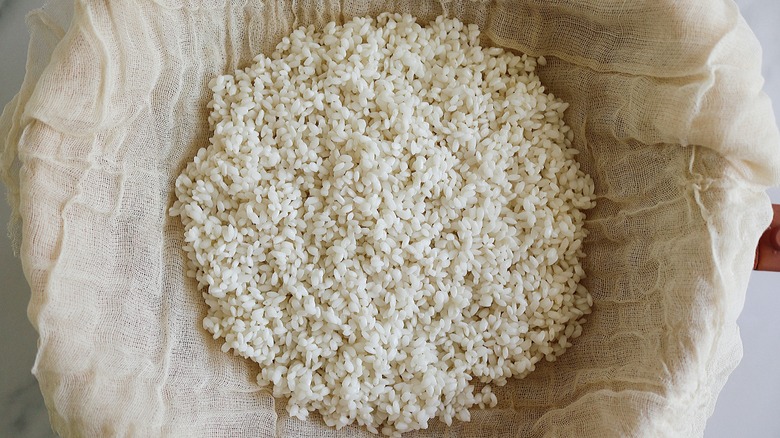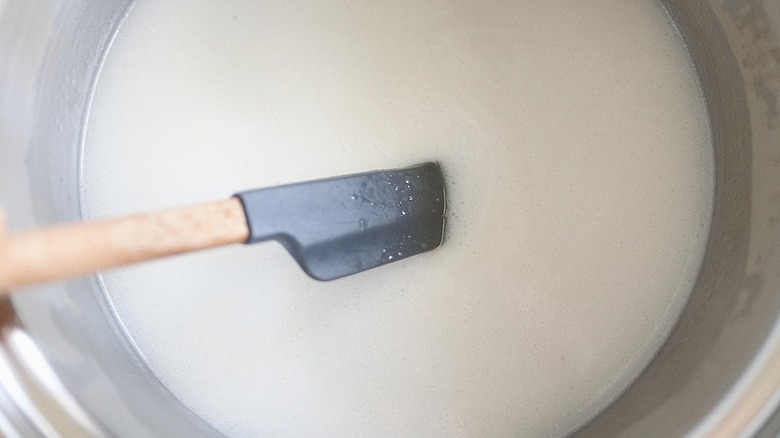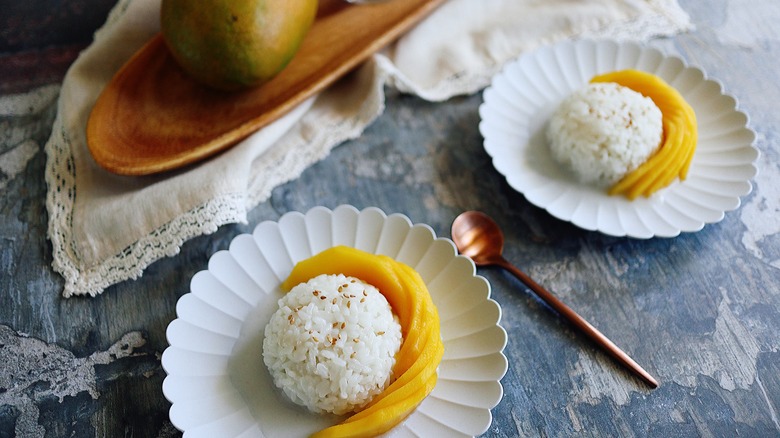Classic Thai Mango Sticky Rice Recipe
While dessert in the U.S. typically consists of cookies, cake, ice cream, pie, or something similarly rich and sweet, other countries have a different take on how they like to end their meals. In Italy or France, a cheese platter may sometimes take the place of dessert, while in Thailand rice topped with sliced mango makes for a not-too-sweet after-meal treat. Should you find that this recipe for Thai-style mango sticky rice is not quite dessert-like enough to satisfy your sweet tooth, though, it might make for a refreshing side dish or a flavorful breakfast food, instead.
The glutinous rice used in this recipe, which is also called sweet or sticky rice, is not the same thing as the standard white rice typically found in supermarkets. Recipe developer Cecilia Ryu says of this rice, "It has a very unique chewy texture ... [and] is commonly used for sweet and savory dishes in Asian cultures." That being said, it is something you may need to purchase from an Asian grocery store or order online. You will also need a steamer to cook the rice, and Ryu suggests cheesecloth for lining the steamer basket, as well. What with sourcing the ingredients and equipment, it may take a little work to put together this mango sticky rice, and in fact even Ryu admits, "This recipe was difficult!" Even so, she tells us, "If you are a mango lover, I would highly recommend trying this recipe."
Gather the ingredients for the Thai mango sticky rice
The glutinous rice, as we just mentioned, is something that you may need to purchase from an Asian grocery store unless your local supermarket has a wide-ranging selection. Mangos, however, are pretty standard fare these days. Should you have access to the kind of produce section that offers a selection of mango types, Ryu notes that champagne mangoes are preferable, saying "They are sweeter and have a softer texture." She also feels that the mangoes should be as ripe as possible, saying "The sweetness of the mango really determines the overall taste of this dessert."
Another ingredient called for in this recipe is unsweetened canned coconut milk for the sauce, which is also readily available. In fact, most canned coconut milk is unsweetened since the sugary kind is usually called cream of coconut or something similar, but you may want to check the label just to be on the safe side. This dish isn't entirely sweetener-free, though, though, as the sauce does call for a small amount of sugar (either white or brown will work) as well as a teeny bit of salt. In addition to these five main ingredients, you could also use roasted (or toasted) sesame seeds as a garnish if you like.
Prepare the sticky rice
Before sticky rice can be cooked, it needs to be rinsed and then soaked. Run cold water over the rice until the runoff is clear, not cloudy, then soak it rice in enough cold water to cover it. The rice will need to soak for at least an hour, but Ryu notes that you can soak it overnight if that is more convenient. The longer the rice soaks, the more quickly it will cook.
When the rice has had a sufficient soaking, line a steamer basket with cheesecloth. Put the rice in the basket, then put the basket over a pot filled with water. Not too much water, though — as per Ryu, "The goal is to steam the rice, not boil it," so it shouldn't be submerged. Cover the pot and basket with a lid, set the burner to medium-high, and let the rice steam for about 20 minutes or so until it's tender. (It may take longer if you only soaked your rice for an hour.)
Make the coconut sauce
While the rice is steaming away, you can make the sauce. As you won't be using an entire can of coconut milk here, Ryu notes that "it is important to stir the coconut milk before measuring" and explains that this is done because "the fat tends to separate in the can."
Mix the coconut milk with the sugar and salt, then cook the mixture over medium heat until it starts simmering and the latter two ingredients have dissolved. Turn off the heat, but don't let the sauce get too cold. If it does cool off to the point where it starts to congeal, you may need to turn the burner back on for a moment until it warms up again.
Arrange the rice and mango on plates
Once the rice is done, mix it with half of the sauce and let it sit for 15 to 20 minutes. This will allow the sauce to be absorbed by the rice. At this point, scoop the rice up by the quarter-cupful — if you're concerned about presentation, you may want to use a cup or ramekin or some other mold that will make a nice rounded dome shape. Even if you don't want to bother with this, a plastic measuring cup should still make for a pretty symmetrical mound. When all of the rice has been portioned out, divide the mango slices between the plates, then drizzle the mango-topped rice with the rest of the sauce. If you want to add a finishing touch, you can also add a sprinkling of roasted (or toasted) sesame seeds.
If you're not planning to eat all four servings at once, any leftover components should be stored separately, then assembled before eating. The rice and mango are fine eaten cold, while the sauce can be quickly reheated in the microwave.
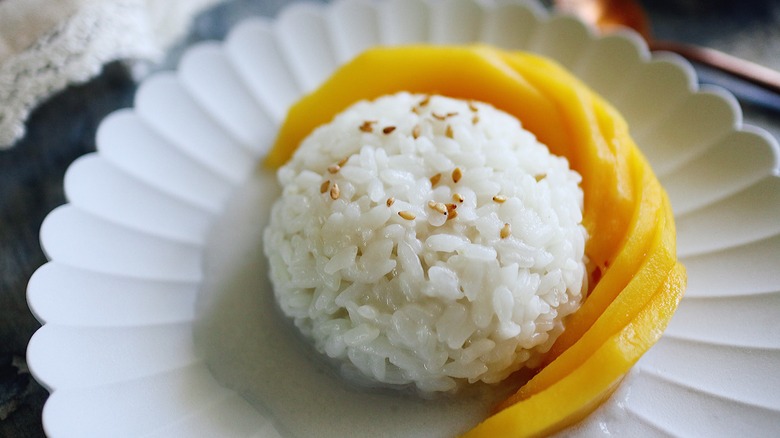
- 1 cup uncooked glutinous rice (sweet or sticky rice)
- 1 cup canned unsweetened coconut milk
- 3 tablespoons sugar
- ¼ teaspoon salt
- 1 mango, peeled, pitted, and thinly sliced
- toasted sesame seeds, for garnish
- Wash the rice in cold running water until the water runs clear.
- Soak the rice for at least 1 hour (up to overnight) in enough cold water to cover it, then drain it.
- Line a steamer basket with cheesecloth and put the drained rice in the basket.
- Place the steamer over a large pot filled with water and cover it with a lid.
- Steam the rice over medium-high heat for 20 minutes, or until it is tender.
- Combine the coconut milk, sugar, and salt in a pot over medium heat stirring until the mixture comes to a simmer.
- Take the sauce off the heat, but do not let it become cold.
- Mix ½ of the sauce with the cooked rice and let the rice sit for 15 to 20 minutes.
- Scoop out ¼ of the rice in a cup or mold that will result in a round, slightly domed mound.
- Place each scoop of rice on a plate and top it with ¼ of the mango slices.
- Drizzle each plate with more of the remaining sauce as desired.
- Garnish the plates with the toasted sesame seeds, if desired.
Nutrition
| Calories per Serving | 373 |
| Total Fat | 12.7 g |
| Saturated Fat | 10.8 g |
| Trans Fat | 0.0 |
| Cholesterol | 0.0 mg |
| Total Carbohydrates | 62.2 g |
| Dietary Fiber | 1.3 g |
| Total Sugars | 20.8 g |
| Sodium | 154.1 mg |
| Protein | 5.1 g |
